Therapeutic hunting programs offer powerful rehabilitation benefits through stress reduction, social connection, and skill mastery. You’ll find adaptive equipment like finger control devices, wheelchair mounts, and specialized triggers that accommodate various disabilities. All-terrain mobility solutions help you navigate challenging landscapes, while custom seating provides comfort during extended hunts. Programs report improved mood, enhanced social connections, and increased confidence among participants. Discover how this unique approach might transform your rehabilitation journey.
The Therapeutic Value of Hunting Activities in Rehabilitation
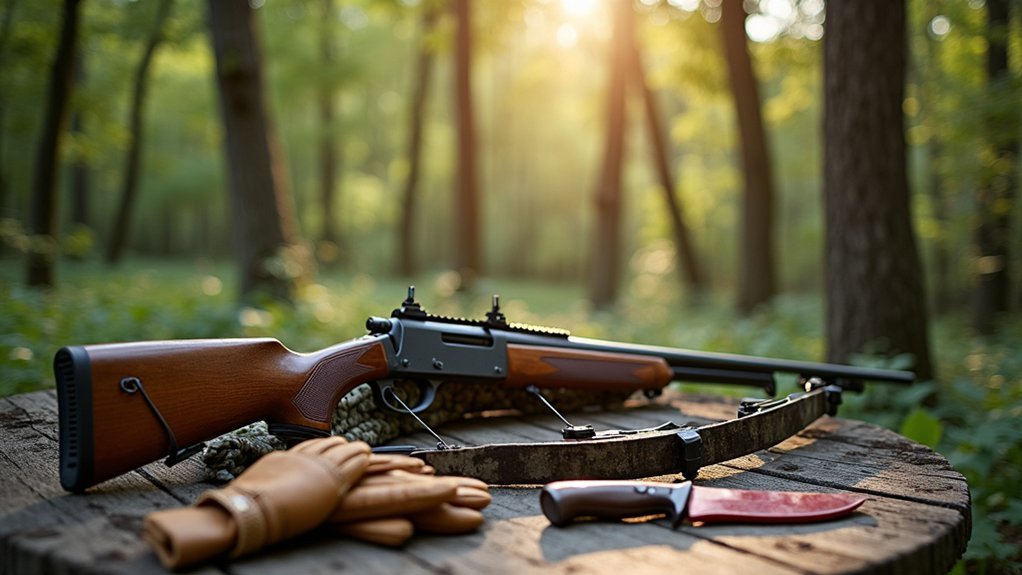
While conventional forms of therapy remain valuable, hunting activities have emerged as a powerful complementary approach in rehabilitation settings.
These experiences offer multiple healing pathways through their unique combination of natural immersion, physical activity, and social connection.
Natural immersion, physical activity, and social connection create powerful healing pathways that transform lives through the hunting experience.
You’ll find that hunting provides anxiety relief through quiet moments in nature that allow for meditation and reflection. Hunting specifically requires mental focus that helps redirect attention away from anxious thoughts.
The physical demands improve your overall health while the cognitive challenges enhance mental clarity and focus.
Many rehabilitation programs now integrate hunting experiences because they’ve proven particularly effective for veterans.
These structured outings help participants process emotions, build resilience, and form supportive social bonds.
When properly customized to accommodate different abilities and needs, hunting activities create genuinely healing experiences that contribute to holistic well-being and personal growth.
Adaptive Firearms and Safety Modifications for Limited Mobility
For individuals with limited mobility, the right adaptive equipment transforms hunting from an inaccessible activity into an achievable pursuit.
Today’s innovative modifications allow you to overcome physical limitations while maintaining safety and accuracy.
Essential adaptive solutions include:
- Finger control devices that let you operate triggers using wrist and arm strength rather than fine motor skills
- Support equipment like the LM100 mount that makes firearms nearly weightless while allowing full directional control
- Aim assistance technologies such as red dot sights and laser pointers that simplify targeting
- Electronic triggers and remote firing mechanisms that eliminate the need for traditional trigger pull strength
- Custom wheelchair mounts and stability equipment that provide secure positioning for seated hunters
Companies like Be Adaptive offer specialized wheelchair-mounted firearm rests designed to accommodate various disabilities.
Specialized Crossbows and Archery Equipment for Various Disabilities
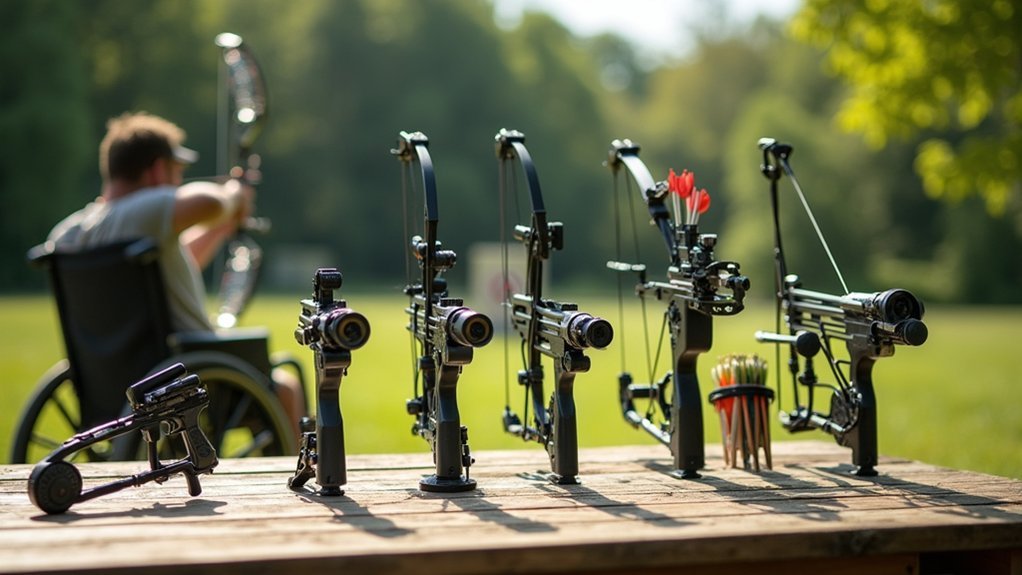
You’ll find adaptive trigger mechanisms provide essential control options for crossbows when standard releases aren’t manageable with your specific limitations.
Wheelchair-mounted release systems transform how you can position and stabilize your equipment, enabling accurate shots without compromising comfort or safety.
Draw-weight reduction technologies make archery accessible regardless of your upper body strength, allowing you to enjoy the therapeutic benefits of archery while using only a fraction of the typical force required.
For individuals who cannot use conventional archery equipment due to an upper extremity disability, a thorough evaluation process conducted by a licensed physical therapist can help determine eligibility for specialized adaptive equipment permits.
Adaptive Trigger Mechanisms
As hunters with physical disabilities seek to reconnect with the outdoors, adaptive trigger mechanisms represent a revolutionary advancement in accessible hunting equipment.
These specialized devices allow you to activate crossbows and archery releases with limited hand function, restoring your independence in the field.
- Lever or button-activated triggers require less grip strength while maintaining shooting precision
- Remote triggers connected by cables let you fire from various comfortable positions
- Mouth-activated and sip-and-puff systems support those with severe upper limb impairments
- Customizable tension settings adapt to your specific capabilities and safety needs
- Compatible mounting systems integrate with wheelchairs and shooting rests for stability
The BT100 Mechanical Bite Trigger offers advanced mouth-controlled activation for hunters with limited or no hand function, providing reliable performance at various shooting angles.
These mechanisms don’t just enable hunting—they’re therapeutic tools that rebuild confidence, foster community connections, and restore meaningful outdoor traditions that support rehabilitation.
Wheelchair-Mounted Release Systems
Wheelchair-mounted release systems represent a breakthrough for hunters with mobility challenges, transforming standard wheelchairs into versatile hunting platforms. These specialized attachable racks secure crossbows firmly to your chair, allowing stable shooting positions without additional support.
You’ll find various positioning systems that let you adjust your crossbow’s angle and height for ideal aim, particularly beneficial if you have quadriplegia or limited upper body mobility. Some models can integrate a simple clothespin-type device that pulls the trigger mechanism for those with limited finger dexterity. Many systems include adaptive handles designed for those with reduced hand function.
Organizations like the Physically Challenged Bow Hunters of America offer resources to help you find appropriate equipment and connect with supportive communities.
Beyond hunting success, these systems deliver therapeutic benefits by improving coordination, building confidence, and fostering independence. The mounting systems’ ergonomic design guarantees comfort during extended hunting sessions, reducing physical strain while maximizing your shooting potential.
Draw-Weight Reduction Technologies
Draw-weight reduction technologies have revolutionized hunting accessibility for individuals with limited upper body strength or mobility. Organizations like PCBA and NYB provide specialized adaptive equipment that makes archery and crossbow hunting possible despite physical limitations.
- Cranking devices such as the Power Draw reduce draw weight by up to 70%, making crossbows manageable.
- Reverse-draw designs shift the riser toward your body for easier shouldering with limited mobility.
- Drawlocks and draw keepers hold the bow at full draw until you’re ready to release.
- Modified archery tackle (PTMAE) supports drawing, holding, and releasing for those with physician certification.
- Adaptive crossbow accessories provide both therapeutic benefits and sporting opportunities while enhancing confidence.
These innovations not only make hunting accessible but also contribute to physical rehabilitation and mental well-being through outdoor engagement. Regular practice with these assistive devices significantly improves hand-eye coordination and concentration, offering therapeutic benefits beyond the hunting experience itself.
Wheelchair-Accessible Hunting Blinds and Tree Stands
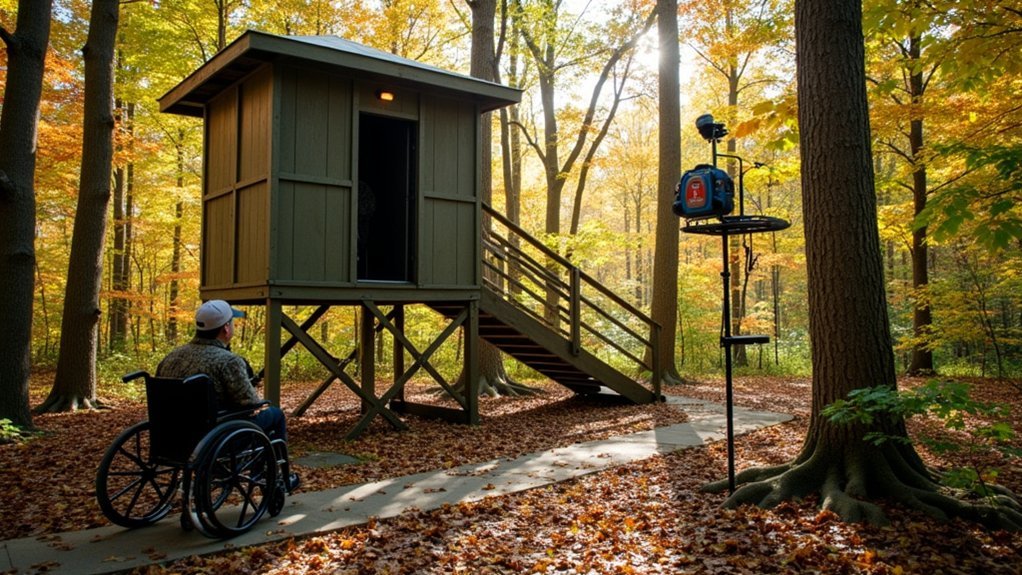
How can hunting enthusiasts with mobility challenges experience the thrill of the great outdoors? Wheelchair-accessible hunting blinds and tree stands provide the answer with features designed specifically for inclusion and independence.
These structures offer modular designs with removable ramps, allowing you to enter and exit with ease. You’ll find options in various sizes from 5×5 to 10×10, constructed with durable materials like steel with powder-coated finishes to resist rust and weather damage. Many models feature a low profile threshold specifically engineered to accommodate wheelchair users with minimal assistance.
The benefits extend beyond the hunt itself. These accessible structures contribute to physical and mental rehabilitation while fostering community connections through shared experiences.
With features like 360-degree tinted windows, marine-grade carpeting for noise reduction, and optional spray foam insulation, you’ll enjoy comfort and capability during your therapeutic hunting adventures.
Mobility Solutions for Accessing Hunting Grounds
You’ll find your hunting experience transformed with today’s innovative all-terrain mobility solutions designed specifically for challenging landscapes.
Modern adaptive transport gear includes specialized wheelchairs with rugged tires, modified ATVs with accessibility features, and portable ramp systems that connect previously inaccessible areas.
These mobility aids don’t just provide access—they restore independence and dignity to hunters who refuse to let physical limitations diminish their connection to outdoor traditions.
The accessibility evolution now includes lowered-floor vans that allow wheelchair users to drive directly to their hunting locations without the barriers that previously limited participation.
All-Terrain Access Solutions
For hunters with mobility challenges, accessing diverse hunting grounds can present significant barriers, but modern all-terrain mobility solutions now provide unprecedented independence.
Today’s specialized equipment can navigate virtually any landscape you encounter, from muddy swamps to rocky mountain trails.
Electric all-terrain options offer significant advantages:
- TrackMaster and TerrainHopper wheelchairs feature high ground clearance and robust suspension systems for conquering uneven terrain
- Action Trackchairs provide stability across mud, sand, snow, and rocky paths
- Electric all-terrain bikes deliver high-torque power with minimal environmental impact
- These vehicles’ reduced noise pollution allows for stealthier approaches to wildlife
- Advanced suspension systems guarantee comfort while minimizing ground disturbance
You’ll experience newfound confidence as these technologies bridge the gap between urban comfort and wilderness adventure, allowing you to participate fully in outdoor activities regardless of mobility limitations.
The Macfox X2 all-terrain electric bike stands out with its exceptional load capacity of 330 lbs, making it ideal for transporting hunting gear and supplies into remote areas.
Adaptive Transport Gear
Beyond all-terrain mobility solutions, dedicated adaptive transport gear serves as the critical bridge between home and hunting locations for sportspeople with mobility challenges. You’ll find specialized vehicles with hand controls, ramps, and securement systems that maintain safety during rough terrain travel. The Digital Crosshairs 1000A can be easily mounted on these adaptive vehicles, allowing hunters to target without having to reposition themselves.
| Transport Option | Key Features | Benefit |
|---|---|---|
| Off-road wheelchairs | Enhanced traction tires | Navigate challenging terrain |
| Modified UTVs | Adaptive controls | Independent operation |
| Transport lifts | Hydraulic assistance | Safe vehicle transfers |
| Accessible trucks | Secured wheelchair mounts | Comfortable long-distance travel |
Many programs offer grant assistance for these adaptive solutions, while volunteer networks provide loading and transfer support. With proper training on equipment use, you’ll experience increased independence and confidence during hunts, transforming the therapeutic benefits of outdoor recreation into reality.
Sensory-Enhanced Hunting Tools for Visual or Hearing Impairments
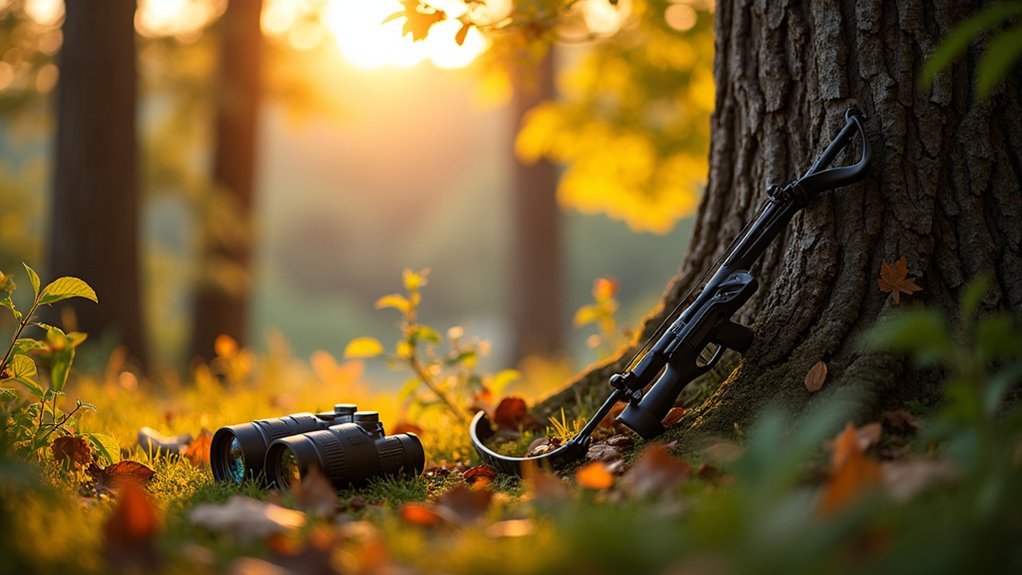
Innovation in adaptive hunting equipment has revolutionized accessibility for hunters with sensory impairments. The Digital Crosshairs 1000SA provides an LCD display clip-on for standard scopes, enabling visually impaired hunters to aim with precision, even at 100 yards.
Adaptive technology transforms hunting accessibility, empowering those with sensory impairments to participate with unprecedented precision.
These tools don’t just enhance capabilities—they restore independence and therapeutic benefits:
- Modular display systems can be mounted on guns or positioned separately for flexible viewing options.
- Assisted targeting features allow blind hunters to participate with a spotter’s guidance.
- Daylight filters improve visibility in various lighting conditions.
- Universal compatibility makes these adaptations work with rifles, crossbows, and pistols.
- Vibration feedback tools provide alternative sensory input for those with hearing impairments.
This pioneering technology has helped thousands regain passion for hunting despite physical limitations.
You’ll find these technologies boost confidence while fostering community integration and skill development.
Grip Modifications and Trigger Adaptations for Motor Limitations
Hunters with motor limitations can now experience the thrill and therapeutic benefits of the sport through revolutionary grip modifications and trigger adaptations.
Adaptive mounting systems like Spartan Precision’s Mr G Clamp provide stable support without permanent firearm modifications, while magnetic adapters enable quick attachment for those with dexterity challenges.
You’ll find adjustable triggers customizable between 1.5-4 pounds, reducing strain on weak muscles while maintaining safety.
For more severe impairments, devices like the BMF Activator translate minimal movements into firing actions through cables or cranks.
Be Adaptive Equipment’s Model HQ100 serves hunters without arm or hand use, creating a weightless feel through precise balancing.
These innovations focus on mechanical simplicity while ensuring reliability—making hunting accessible regardless of your motor abilities.
As demonstrated in Asher’s case, these adaptive tools enable even severely disabled youth to harvest animals independently while creating meaningful family bonding experiences.
Electronic Hunting Aids and Assistive Technologies
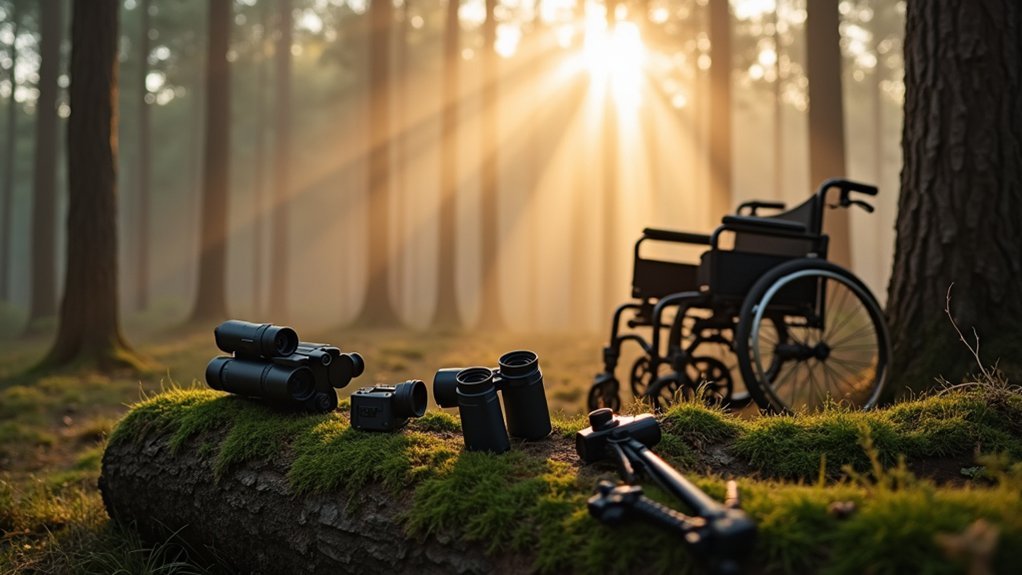
Four transformative electronic technologies have revolutionized hunting accessibility for those with disabilities. Electronic sights and scopes enhance visual capabilities through digital crosshairs and assistive displays, allowing you to overcome visual impairments while hunting.
- Video targeting systems project crosshairs onto external displays, making aiming possible from various positions.
- Smartphone integration with scopes enables recording and magnification for improved visibility.
- Adaptive hearing devices amplify environmental sounds while protecting your hearing from gunshots.
- Modular mounting systems with picatinny rails accommodate various accessibility needs.
- Assistive displays can be positioned away from your rifle, ideal for hunters with mobility challenges.
These technologies don’t just compensate for limitations—they enhance your hunting experience through digital innovation, making therapeutic rehabilitation through hunting accessible to everyone. Products like the iScope system allow users to attach smartphones directly to rifle scopes, creating a more accessible viewing option for those with visual impairments.
Custom Seating and Positioning Equipment for Extended Hunts
When you’re spending hours waiting for the perfect shot, custom seating and positioning equipment becomes essential for both comfort and therapeutic benefit.
These specialized solutions improve your posture while reducing fatigue and injury risk during long hunts.
Options range from adaptive cushions and wedges to bean bag chairs and vibrating pillows that provide sensory feedback. The Tumble Forms 2 wedges are particularly effective for maintaining proper alignment during extended sitting periods. Your input is vital in designing seating that meets your specific needs.
The design process includes thorough assessment, material selection, and ongoing adjustments to accommodate changing physical requirements.
Proper positioning not only enhances your hunting performance through better equipment control and precision but also supports rehabilitation by enabling full participation despite physical limitations.
With ergonomic, adjustable seating tailored to your body, you’ll experience improved mind-body connection and long-term health benefits beyond the hunt itself.
Balance and Stability Devices for Field Use
Balance and stability don’t just matter in your stand—they’re fundamental elements throughout your entire hunting experience.
Modern rehabilitation equipment offers specialized solutions that enhance your outdoor therapy while ensuring safety and progressive improvement during hunts.
These field-ready devices provide essential support for various conditions:
- Dynamic balance systems like OmniStand® offer adjustable support for traversing varied terrain safely
- Balance wedges and boards engage your core muscles through micro-movements, improving overall stability
- Stability balls and half-domed options provide versatile proprioceptive training adaptable to field use
- Platform-based devices with handles reduce fear of falling on uneven ground
- Balance beams with different width options reinforce trunk musculature during movement
With proper equipment, you’ll gain confidence, improve mobility, and experience significant reductions in fall risk during therapeutic hunting activities. Many devices incorporate serious games to increase engagement and motivation during rehabilitation exercises in outdoor settings.
Mental Health Benefits of Therapeutic Hunting Programs
Therapeutic hunting programs offer profound mental health benefits that extend far beyond the physical rehabilitation aspects of outdoor activities.
You’ll experience significant stress reduction as nature’s peaceful environment and calming sounds lower your blood pressure and heart rate.
For veterans struggling with PTSD, these programs provide essential nature therapy while fostering social reconnection with peers.
The meditative routines of tracking and waiting create a sense of calm that helps you leave daily stresses behind.
As you develop hunting skills, you’ll build confidence and self-esteem through tangible accomplishments.
The responsibility of providing food creates purpose and fulfillment, while spending time outdoors increases your vitamin D intake and energy levels.
This natural environment acts as an antidepressant, enhancing your overall well-being and mental clarity.
Through hunting activities, many participants strengthen meaningful relationships as they are often introduced by family members and continue traditions that span generations.
Community Hunting Programs for Rehabilitation Patients
Community hunting programs have transformed countless rehabilitation patients’ lives through shared outdoor experiences that build confidence and foster recovery.
You’ll find these programs offer specialized equipment and trained staff to accommodate various disabilities, ensuring everyone can participate regardless of physical limitations. These programs provide patients with opportunities to develop cognitive and physical skills while engaging in meaningful outdoor activities.
The therapeutic value of hunting activities extends beyond recreation, providing meaningful rehabilitation milestones as patients develop motor skills, problem-solving abilities, and social connections in a supportive environment.
Group Success Stories
Numerous rehabilitation patients have found remarkable healing through organized hunting programs designed specifically for their recovery journey.
These transformative experiences create lasting impacts that extend far beyond the hunting field. Many patients develop a deeper appreciation for white-tailed deer conservation while finding personal healing through their engagement with nature.
- Veterans with PTSD report significant reduction in symptoms after participating in guided hunts where they form bonds with others who understand their experiences.
- Patients recovering from physical injuries develop newfound confidence through mastering adaptive hunting techniques.
- Community integration becomes easier as participants connect with mentors and fellow hunters through shared experiences.
- Emotional healing occurs naturally in outdoor settings, helping patients process trauma while learning valuable skills.
- Some participants discover new career paths in conservation or outdoor education, giving purpose to their rehabilitation journey.
Access and Accommodation
While rehabilitation patients can benefit tremendously from hunting programs, accessing these therapeutic resources often presents significant challenges. Many face physical barriers similar to those encountered in traditional rehabilitation settings, along with financial constraints from equipment costs and program fees.
You’ll find that effective programs provide specialized adaptive equipment to accommodate physical limitations, ensuring you can participate regardless of mobility challenges. Safety remains paramount, with trained instructors who understand both rehabilitation principles and hunting techniques.
Community support is essential for these programs to thrive. Local partnerships with healthcare providers enhance therapeutic outcomes, while volunteer engagement helps overcome funding constraints. Different pricing structures can make therapeutic hunting more accessible, similar to how permit prices vary for domestic and international hunters in established trophy hunting programs.
When communities and healthcare organizations collaborate, they create environments where you’ll experience not just physical improvements but also mental health benefits and social connection through these specialized hunting experiences.
Hunting as Therapy
Experiencing the therapeutic power of hunting goes beyond mere accessibility—it’s about the profound healing that occurs when rehabilitation meets outdoor adventure.
When you participate in community hunting programs, you’re not just learning a skill—you’re engaging in a therapeutic journey.
These programs offer thorough benefits for rehabilitation patients:
- Stress reduction through immersion in natural environments
- Social connection and camaraderie, especially valuable for veterans
- Development of confidence and self-esteem through mastering new skills
- Cognitive improvements from engaging with nature and strategic thinking
- Mental health support in a non-clinical, adventure-based setting
Though formal research remains limited, participants consistently report improved mood, enhanced social connections, and a greater sense of accomplishment—making hunting a unique and effective therapeutic approach for many rehabilitation journeys.
It’s worth noting that community hunting programs can also help participants avoid heavy alcohol use, which affects 9.7% of workers in the agriculture, forestry, fishing, and hunting industry.
Insurance Coverage and Funding Options for Adaptive Hunting Equipment
How do adaptive hunters protect their specialized equipment investment? Standard homeowners policies typically offer limited coverage for adaptive hunting gear, often requiring specialized endorsements to fully protect these items.
Consider outdoor sports enthusiast policies that specifically cover theft, damage, and loss of customized equipment. Be aware that these policies may have specific coverage limits for firearms and other valuable adaptive equipment.
You’ll find various funding alternatives if you’re facing financial barriers. Nonprofit organizations offer grants dedicated to adaptive hunting equipment, while state vocational rehabilitation programs may provide subsidies that support therapeutic goals.
Don’t overlook adaptive sports organizations with loaner programs or manufacturer partnerships that reduce costs.
For ongoing protection, look into extensive insurance packages designed for disabled sports participants that cover both equipment and liability concerns—especially important when participating in group hunting activities or organized events.
Frequently Asked Questions
How Do I Find Hunting Mentors Experienced With Disability Accommodations?
You’ll find disability-accommodating hunting mentors through NRA Adaptive Shooting Programs, state hunting organizations, disability-focused hunting groups, inclusive hunting events, and by contacting local conservation groups. These resources connect you with experienced guides tailored to your needs.
What Wildlife Interaction Precautions Should Rehabilitation Patients Take?
If you’re undergoing rehabilitation, avoid taming wildlife, minimize interaction to prevent imprinting, stay quiet around animals, keep pets away, and respect animals’ need for natural environments without human habituation or public viewing.
Can Hunting Therapy Complement Traditional Physical Rehabilitation Exercises?
Yes, hunting therapy can complement your traditional rehab exercises by providing physical engagement, mental stimulation, and stress reduction in a natural setting. You’ll develop new skills while working toward specific therapeutic goals.
How Are Caregivers Integrated Into Therapeutic Hunting Programs?
Caregivers are often integrated as active participants who learn alongside patients, receive training on supporting techniques, provide physical assistance when needed, and help transfer therapeutic benefits from hunting experiences to daily life.
What Emotional Readiness Is Needed Before Starting a Hunting Therapy Program?
You’ll need adequate emotional stability, readiness for change, affect management skills, and therapeutic engagement capacity. You should acknowledge trauma impacts, manage distress, and be willing to trust the process and be vulnerable.
In Summary
You’ve seen how therapeutic hunting provides both physical and mental healing pathways. With today’s adaptive equipment, you’ll find that limitations don’t mean the end of outdoor passions. Whether you’re recovering from injury or managing chronic conditions, don’t hesitate to explore funding options and community programs. By embracing these specialized tools and resources, you’re not just hunting—you’re actively participating in your recovery journey.

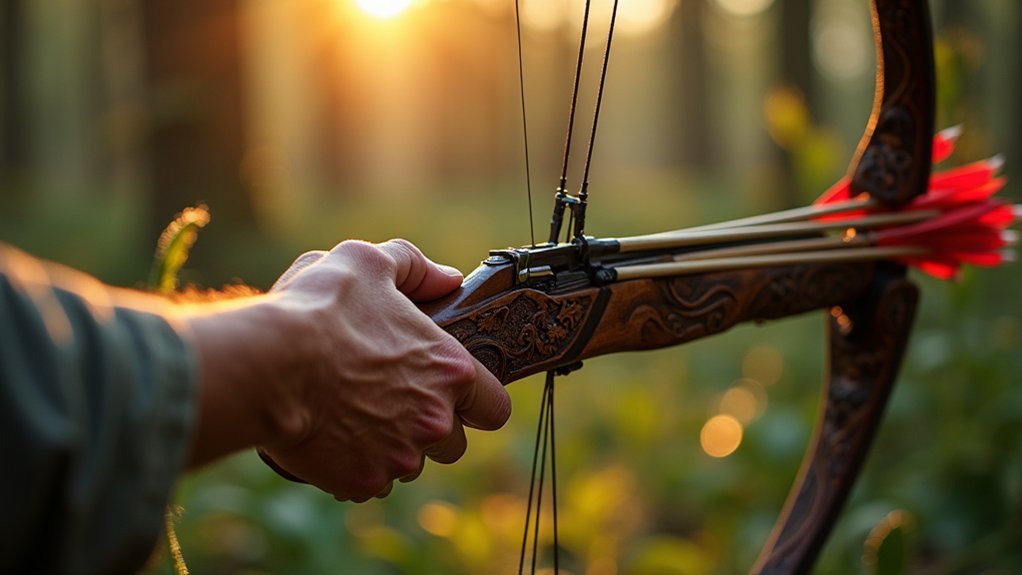



Leave a Reply